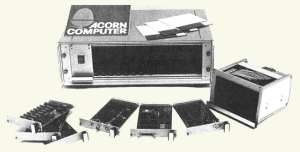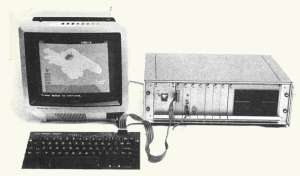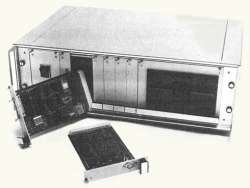
This review should start—"from little acorns, giant oak trees grow". The machine is Science of Cambridge's (sic) modular computer system, starting with System One and ending with System Four. The photographs show the System Three level lent by S. of C. for review. To a great extent it is the Software which distinguishes this machine; and, as the photograph shows, its compatibility as a Prestel terminal for the Post Office's new remote processing link. The video from the machine is in full colour, which unfortunately cannot be appreciated from accompanying photos.
The System One costs £65, and the System Two with card frame, backplane (and four sockets), CPU board, cassette and VDU interface, 4K RAM, Software monitor and 4K BASIC will set you back £285 as a kit. A further £200 will buy a fully assembled and tested version, with the additions of case, 5V 3A PSU, buffered backplane and 8 sockets, 4K more of RAM, front panels, connectors and an 8K BASIC. At the time of writing, software was being supplied in EPROM (2732's) and an EPROM surcharge of £50 on the System Two was in force. Each additional component is available separately from S. of C., and this is one of the great advantages of the device, a small start does not imply that you'll need to buy a different computer to gain greater sophistication.

System Three takes the user to mini-floppy disk storage, all neatly fitting into the rack, and the System Four adds another rack to give maximum expandability for the system up to full memory and two 5¼" drives. The System Three photographed here has three 8K RAM boards, CPU card, cassette interface card, VDU card, PSU, fully socketed card rack (with one blank panel here) and mini floppy. The total cost without TV monitor would be around £1,300 assembled and tested (including an ASCII keyboard, which comes cased). S. of C. will also sell you a Sony Trinitron colour monitor for £350. The total disk storage included is 80-90K.
Physically, the p.c.b.s are a high-quality plated-through product which seem easy enough to assemble and are, of course, fully solder-resist coated. The VDU Controller used is the 6845, which is fast becoming the industry standard, and the disk controller—the 8271 chip. S. of C. supply data sheets on all the devices used within their system at £1 each.
Expansions to the basic system include a Universal Interface board with parallel and serial ports, for hardware control, and a 6809 board to evaluate this processor via a software monitor (which is also included).
The photographs of the working system show a picture of the Post Office's "Busby" logo for a very good reason—S. of C. provide software and hardware to interface with the Prestel and Teletext System.
Automatic "booting" of a program stored on disk is possible on RESET, and the disk is given an "option" number by the OPTION command to allow the following modes:
Option 0: do nothing upon RESET (i.e. stay in DOS)
Option 1: load the file "BOOT"
Option 2: run the file "BOOT"
Option 3: execute the file "BOOT"
The last option allows the file called "BOOT" to contain Commands as if typed in from the keyboard. Thus, if BOOT contains the Bytes "BASIC" (a five-byte string: B,A,S,I,C,); then, assuming the BASIC interpreter is resident on the disk, BASIC will be booted in automatically on RESET.
Any other commands may be contained in "BOOT" for this option, and BOOT is called a "command" file—very useful for some clever software tricks.
Automatic messages may be produced upon accessing given files, and these give programs a more professional and "turnkey" air when used along with Option 3 above. Other DOS commands available are the usual LOAD, SAVE and DELETE for disk files; EXEC and GO for executing machine-code routines directly and INFO to find out about the files stored in a disk, usually after a CAT command, to display the catalogue of existing files. The information returned is: qualifier, whether or not protected, file name, LOAD and RUN addresses, length of file and start-sector on disk.
The DOS also produces a familiar set of disk error messages such as "clock error", "sector not found", etc., which can help to locate bugs in the hardware of the drive if necessary.
The processor card contains 1K of RAM and 104 of these locations are reserved especially for the upper-case single-letter variable names (A,B,C, etc). These are always tested first, and provide a set of fast-access variables. In addition, single single lower-case letters are available for line labels. Thus: 10 a PRINT "hello"
20 Goto a
would put "hello" endlessly onto the screen.(Actually I think it would have to be "GOTO a". Keywords were upper-case.)

A feature called "word indirection" is available whereby the result of a calculation can be stored directly into a given set of four contiguously addressed bytes. In such a process, direct access to the Addresses of data bytes is thus greatly simplified. In addition, hexadecimal numbers may be used directly within a calculation by using the £ sign as a prefix. Thus, PRINT £AF gives the result 175, on the screen. Thus Hex numbers may be added and printed using: PRINT £AF + £13
this gives the result C2—great for hex calculations! The DO—UNTIL statement is provided in System Three BASIC, allowing loops to be processed until a given condition is satisfied. This can be useful in numerical methods for instance, or in control functions.
The statement "LINK" allows machine code statements to be run from BASIC, in a similar manner to the more familiar "USR" function. Bytes, complete frames of 4 bytes and strings, may be "got" from and "put" to sequential data files using the usual variety of statements which one would expect in a disk BASIC. All the familiar BASIC statements are available, with the usual optional use of LET and END statements. No ELSE is allowed in IF statements, and the BASIC supplied has no floating point package. This is available as an extension.
Another extension is the graphics package which functions as follows: The screen is divided into 78 x 75 dots or Pixels (picture elements). The Busby picture shows the resolution of the system. Individual pixels are rather large, but adequate for Teletext and Prestel.
To set up a pattern on the screen, several commands are available. CLEAR clears the screen and places it in graphics mode, as well as setting the colour of the pixels to be plotted. PLOP, MOVE and DRAW then allow lines and points to be displayed on an X,Y Co-ordinate system based at the bottom left-hand corner of the screen.
Special letters are left in the text to signal particular printing modes, such as justification, given line-widths and the centering of a heading on the page. Strings may be located, deleted, and changed as normal. Only one character may be inserted after the cursor for each use of the insert command, which is rather limiting as far as speed is concerned. Text is entered one page at a time, and the operator must not exceed this limit, or an overflow message appears. A page is defined as a full screen.
The version of the editor supplied with the machine for review appeared rather cumbersome and slow to use compared with other packages, but this may well have been due to the rather scant and embryonic documentation accompanying the program.
LISP is a language which is orientated towards the processing of strings and lists of characters as opposed to scientific and numerical calculations, though calculations are possible. Complex data structures are easy to construct, and the language can process and act upon complex "Boolean" or logical conditions. This type of programming is suitable for highly interactive routines using human language for communication. The computer can easily be made to act as if it understands syntax and grammar. As an example, as a demonstration of LISP's capabilities, OWL computers have a program called DOCTOR which pretends to be your psychiatrist, and asks personal questions in an English conversation—could become addictive!

The exact market for the machine is difficult to assess. Medium-sized business applications would be difficult with such small disk space, and the system would have to be cheaper for the hobbyist to buy it. That leaves Education and hardware control. Both of these would surely benefit from the modularity and Input/Output expansions available. ¨
|